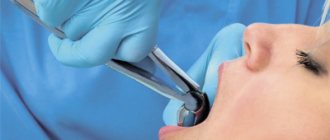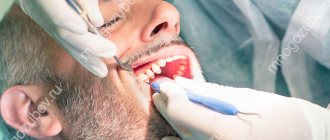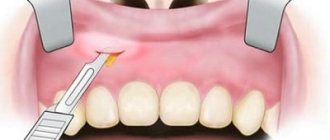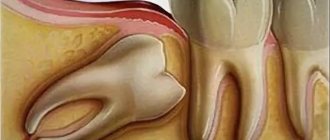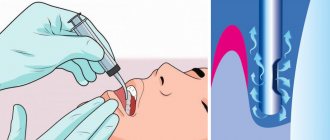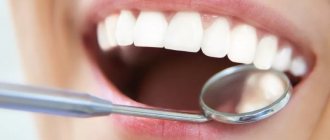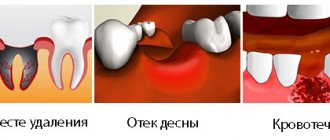31.10.2019
Wisdom teeth are removed for various reasons, but the main ones are related to either the need to correct the bite or the fact that inflammation has occurred. Removal is often difficult, and the doctor places sutures on the gums, and also warns the patient about the development of swelling of the cheek and pain in the gums 2-3 days after surgery. All this can worry the patient, and he will only think about when the gums will heal. Unfortunately, the answer to the question of how long it takes for the gums to heal after wisdom tooth removal depends on the specific situation and individual characteristics of the patient.
What to do after wisdom tooth removal
On this day, it is better to go home and relax: sleep, read a book, watch your favorite show or movie. It is not recommended to move a lot and intensively, or engage in physical labor.
Starting from the second day, it is necessary to rinse your mouth with antiseptics and take antibiotic medications to prevent the development of infectious and inflammatory diseases. The doctor decides which antibiotics to take after wisdom tooth removal. If there are no recommendations, then you can choose any medications with a wide spectrum of action.
Intense rinsing is not recommended, licking the blood clot is strictly prohibited, otherwise this will lead to the effect of a dry socket. A plug of clotted blood protects the resulting cavity and jaw bones from food particles and bacteria getting inside.
Do not consume hot or too cold foods, drinks, or overheat the body. Visiting the beach, baths, saunas is prohibited.
Smokers will have to give up cigarettes for 2, 3 days, or better yet for a week. Nicotine does not allow the wound to heal quickly, as it constricts blood vessels. Tissues are poorly saturated with oxygen and nutrients, and are more easily susceptible to infection.
A repeated visit to the doctor is necessary, even if the stitches do not need to be removed. The doctor will examine the wound, be able to identify complications in time and prescribe the correct treatment. You should not wait until the date of re-appointment if there is severe, ongoing pain, or the appearance of pus in the socket.
Eating food
The period of time during which you cannot eat after tooth extraction depends on the individual characteristics of the patient and the complexity of the operation performed. Most often, a couple of hours after removal, specialists allow you to eat something liquid. Dairy products, such as yogurt or kefir, are good for this. Thanks to such food, the body will quickly be satisfied, and the site of tooth extraction will not be damaged. During your first meal, you should not eat chips, crackers or deep-fried meat. Such hard food will greatly damage the cavity.
If your temperature rises after wisdom tooth removal
The symptom may occur immediately after extirpation. This is due to the action of the immune system in response to tissue injury and invasion of foreign elements into the body.
Doctors recommend taking antipyretics and using cold compresses to remove heat locally.
If the patient then develops a fever several days after extirpation, this may indicate the presence of an inflammatory process. The most common is alveolitis. It is accompanied by acute pain, which can radiate to the throat, temple, ear, depending on where the hole is located. If, when you probe the hole with your tongue, you feel an empty cavity, then you need to urgently go to the dental clinic where the surgery was performed.
Dental drainage: what it is, what it looks like
What is tooth drainage? Translated from English, “drain” means “to drain.” This is a medical instrument or device, the main purpose of which is the continuous removal of liquid contents from inflamed tissues and cavities. Usually it is inserted into open wounds and left for a short time, thus, with its help, a procedure is carried out that promotes the outflow of pus, serous exudate, blood and ichor.
This device was first invented by a French surgeon. It was originally created from materials such as glass and rubber. Today, lighter, softer and smoother materials are used for manufacturing: rubber, silicone and latex - they do not get wet, are well fixed and hold, and do not cause significant discomfort.
If you want to know what dental drainage looks like, look at the photo below. This device looks like a small thin tube, and in some cases it even looks like a thin wire, tape or just a strip of material. The device has different sizes and diameters.
How to relieve pain after wisdom tooth removal
The doctor prescribes drugs for pain relief to the patient. If there is no list, but the pain is severe, then you can buy Tempalgin, Baralgin, Ketanov and similar medications. Medicines must be taken according to instructions. If you take too many tablets, it will lead to side effects. One tablet is usually enough to stop an attack. Take three times a day.
In addition to medications, pain can be reduced with cold. A cold compress is applied to the cheek for 15 to 30 minutes up to four times a day. You can use pieces of ice or frozen food from the freezer. They are placed in a plastic bag and a towel, and then applied to the sore spot.
Ultrasound removal of tartar - features of the technique
We are talking about a modern and effective method of professional cleaning of enamel from plaque and tartar. Solid deposits have a mineral-salt composition, which makes its removal fraught with some difficulties, and most comprehensive hygiene methods do not help here. In this regard, ultrasound is one of the few ways to guarantee the removal of hard tartar. Dental experts recommend undergoing such prophylaxis at least once every 6 months. Among the characteristic features of the procedure, the following points can be highlighted:
- the session usually does not take more than 40-60 minutes,
- first, soft plaque is removed, the smallest food remains are removed from the spaces between the elements of the row,
- after this, the doctor begins to carefully remove supragingival deposits,
- then they move on to removing subgingival stone, for which they carefully expose the neck of each tooth,
- At the final stage of the procedure, the enamel is treated with a special fluoride-containing paste.
Many people are interested in the question of whether it is painful or not to undergo cleaning. Tartar removal using ultrasound is a completely painless procedure, but in some cases it can cause some discomfort. But don’t be afraid of severe pain - there won’t be any, because only the upper protective layer of the teeth is affected.
What can you eat after wisdom tooth removal?
It is forbidden to put anything in your mouth for two hours after extraction. During this time, a plug of condensed blood is formed and fixed on the socket, which is necessary to protect against the entry of various elements, including pathogens. If you are very thirsty, you can do this through a straw or in small sips.
On the first day, you can drink non-hot drinks and eat liquid porridge, yogurt, and soups. Over the next few days, you should adhere to the following recommendations:
- food must be at a comfortable temperature; hot and too cold food is prohibited, including drinks;
- it is necessary to exclude solid foods that can injure the gums;
- You need to chew food on the side that has not undergone surgery;
- After each dose, you need to rinse your mouth with a warm saline solution;
- If your immune system is weakened, you can take additional multivitamins.
It is better to refuse or limit sweet, spicy foods, alcohol, and carbonated drinks.
Is ultrasonic teeth cleaning harmful?
The ultrasonic scaler does not have any negative effects on the patient’s body - the technique is considered absolutely safe. Above we have already outlined a number of restrictions on its use. Only ignoring these contraindications and violating the technology of the procedure can lead to unpleasant consequences, and the most common of them is hyperesthesia - increased sensitivity of the enamel due to its too much trauma and thinning. Among other possible problems, experts highlight accidental damage to gum tissue, its possible inflammation and infection.
How to rinse your mouth after wisdom tooth removal
The first few hours after extirpation, rinsing is strictly prohibited. This can lead to the natural plug being washed away, exposing the socket and bone. If bacteria penetrate inside, alveolitis or osteomyelitis will develop.
From the second day, carefully, not intensively, rinse your mouth with various antiseptics:
- chlorhexidine;
- miramestin;
- furatsilin;
- diluted potassium permanganate.
At home, you can prepare a solution with salt, soda, and add a few drops of iodine to the water. Herbal decoctions with sage, eucalyptus, chamomile, calendula, and oak bark perfectly relieve swelling and inflammation.
What is the principle of ultrasonic cleaning
The procedure is based on the destructive action of high-frequency ultrasonic waves aimed at hard dental plaque. For this, a special device is used - a scaler. Exposure to waves leads to the complete destruction of hardened tartar, literally turning it into powder. Due to the simultaneous supply of water, plaque and sediment particles are instantly removed. The main advantage of the method is the ability to effectively clean subgingival pockets, which is not so successfully handled by other types of professional cleaning.
How long does it take for gums to heal after wisdom tooth removal?
It is impossible to answer this question unambiguously, since the answer depends on the following factors:
- difficulties of extirpation - with a simple procedure, the tissues are minimally injured, which means the hole will heal within a few days; with incisions in the gums, the tissues heal for several weeks;
- age - faster for young people;
- the presence of complications, inflammatory processes that delay healing indefinitely until the infection is eliminated;
- compliance with doctor's instructions for the rehabilitation period;
- individual characteristics of the body.
Actions after the procedure - prevention
To minimize the intensity of dental plaque formation, proper care and prevention should be provided. To do this, experts recommend adhering to the following rules:
- use a brush whose degree of hardness corresponds to the condition of your enamel - it is better to consult a specialist on this matter,
- carry out standard cleaning daily - after waking up and before going to bed,
- You need to brush your teeth in a circular motion for at least 5 minutes,
- after eating, do not forget to floss, rinse your mouth to remove food debris after a meal,
- for better care, it is worth purchasing an irrigator - a portable device supplies a powerful stream of water and air under high pressure,
- do not forget about the back side of the rows, as well as the surface of the tongue, where a huge number of bacteria are concentrated,
- include hard vegetables and fruits in your diet - when biting, the enamel is cleansed of microbial plaque,
- eat less sweets, limit your consumption of sugary drinks, coffee and black tea. You also need to stop smoking.
To maintain hygiene, it is recommended to undergo a comprehensive cleaning twice a year. According to experts, this is the optimal frequency that will prevent the formation of too much deposits that can provoke the development of caries and other dental problems.
Indications for installing the system in the gums
Let’s take a closer look at who gets drainage and why. Many patients consult a doctor with an acute inflammatory process and severe swelling of the tissues of the oral cavity (and sometimes even the face), caused by advanced diseases and accompanied by the appearance of a lump or abscess on the gum.
In this case, it is simply necessary to resort to surgical measures, namely, to cut the inflamed gum, as well as the abscess, and release its contents. To prevent the wound from quickly overgrown again, and to prevent pathogenic contents from remaining and accumulating inside it again, specialists place a drainage on the tooth.
So, the main indication for installing the device: a purulent-inflammatory process in the mouth caused by pathologies such as advanced pulpitis and periodontitis, gumboil, fistula, abscess, cyst and granuloma. A wide opening of the purulent cavity and drainage of pathological foci are also carried out in such serious diseases as odontogenic osteomyelitis and phlegmon [1], when the bone structures of the jaw and soft tissues of the face are affected.
On a note! The procedure is contraindicated in patients with bleeding disorders and allergies to painkillers used during the operation and the incision on the gum.
Features of the procedure
Let's take a closer look at how drainage is placed on a tooth. The procedure includes several important steps.
Stage No. 1
First, the specialist conducts a thorough visual and x-ray examination of the inflamed area to get an accurate idea of the location of the abscess, its size and depth.
Stage No. 2
The doctor administers local anesthesia so that the patient does not experience pain during the procedure. Next, at this stage, surgical intervention is performed.
If the tooth next to which the abscess has appeared can still serve, then the specialist cuts the inflamed gum with a scalpel. In cases where saving the tooth is not practical, the dentist removes its root, after which he places a tube to drain the fluid directly into the open socket (in this case, no tissue incision is made).
Stage No. 3
The opened purulent cavity is thoroughly cleaned, treated with antiseptic solutions, after which drainage is fixed in it. One end of the device is inside the wound, and the other is outside.
Next, the doctor prescribes medications, antiseptic rinses and antibiotics for home use, which, together with the installed device, will work to quickly eliminate the inflammatory process and normalize the patient’s condition.



